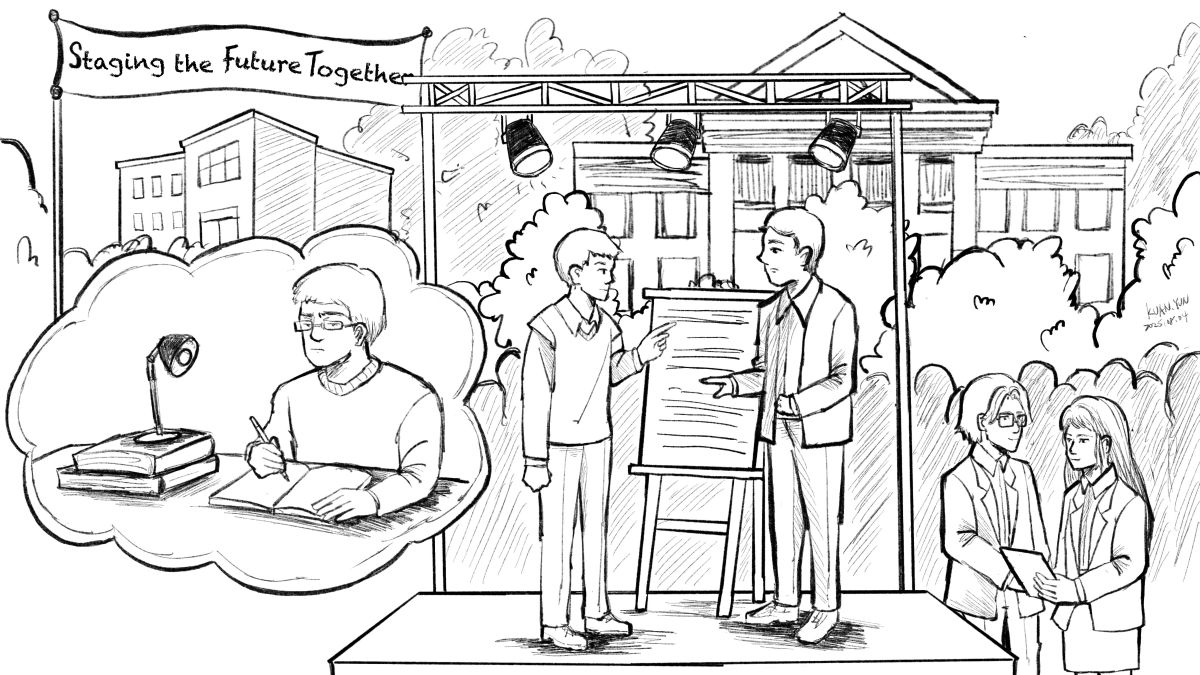NEWS
President's Letter
- Publish Date:2025-08-04
What Is USR?

(Image credit: Kuan-Yun Chen)
Narrated by NYCU President Chi-Hung Lin
Interviewed by Yen-Shen Chen
Written by Yen-Chien Lai
Proofread by Yu-An Lu
Interviewed by Yen-Shen Chen
Written by Yen-Chien Lai
Proofread by Yu-An Lu
______
A few years ago, my son had just started college and enrolled in a course called “Service Learning.” I asked him, “What did you do in that class?” He cheerfully replied, “We cleaned the streets in a nearby neighborhood, and after we finished, the borough chief even treated us to drinks.”
I wasn’t sure whether to laugh or cry. As a parent, I thought it was wonderful that young people were serving their community. But as a university president, a more pressing question came to mind: “Is the goal of a service learning course to cultivate socially engaged citizens who truely understand their communities, or merely to produce transient visitors who sweep the streets once and move on?”
In recent years, University Social Responsibility (USR) has become a buzzword in higher education. The Ministry of Education launched several initiatives, universities followed through, students earned their required service hours, and local communities benefited from free human resources. It all sounds well-organized and mutually beneficial. But from my perspective, if USR simply becomes “taking students to sweep streets and visit the elderly, then submitting a report to wrap things up,” we may have completed the form—not not fulfilled the purpose.
“Service Learning” or “Learning to Serve”?
Why is service important? We often simplify the role of universities into three missions: teaching, research, and service. In recent years, the first two–education and research–have been dramatically reshaped by artificial intelligence (AI). Especially with the rise of generative AI, the dynamics between students and teachers are being redefined. So perhaps it’s time to reconsider what “service” truely means.
I’ve observed that “service learning” sometimes becomes a performative process: bringing students into communities to carry out charitable work. But few stop to ask: What are the real challenges facing this community? Are we here to help address those root issues, or merely to fill short-term human resource gaps?
USR should not stop at the posture of “I’m here to help you.” It should evolve into the mindset of “Let’s work together to find solutions.” That shift marks a generational leap in educational philosophy.
From “What We Do” to “Why We Do It”
I believe universities should have the courage to confront real-world problems. Take, for example, a nearby community that appears unkempt. The issue may not simply be a lack of cleaning services but rather deeper, systemic challenges—such as ineffective waste removal policies, ingrained living habits, or low levels of civic awareness among residents. The Bill & Melinda Gates Foundation doesn’t merely donate money or provide short-term relief. Instead, they invest time, talent, and resources to investigate the root causes of social issues. That’s why they’ve achieved meaningful progress in reducing child mortality and combating malaria in Africa.
That’s why I often tell colleagues: USR is not about sweeping someone else’s streets, but about asking why the streets keep getting dirty. Our goal is not to solve problems for the community, but to solve problems with the community.
Once the problems are identified, we must adopt an experimental mindset—exploring specific issues in specific locations, with specific populations, over a defined period of time.
This approach not only provides students with authentic, real-world learning environments, but also enables teams to test feasible and replicable solutions—even within the constraints of incomplete regulations or imperfect conditions.
Take, for example, the real issue of a nursing workforce shortage. Everyone suggests “train more nurses” or “offer higher pay”—and indeed, the government and hospitals have already implemented such measures. Yet the real bottleneck may lie elsewhere: many newly trained nurses leave the profession within five years for a variety of reasons. Could we explore ways to support licensed, passionate nurses who have left the field in returning to work?
That’s the kind of experimental issue I hope to pursue. We’ve already begun collaborating with hospitals and government agencies to create platforms that enable these “half-time professionals” to re-enter the workforce. It may not be a perfect solution, but it’s a meaningful starting point for problem-solving.
A few years ago, my son had just started college and enrolled in a course called “Service Learning.” I asked him, “What did you do in that class?” He cheerfully replied, “We cleaned the streets in a nearby neighborhood, and after we finished, the borough chief even treated us to drinks.”
I wasn’t sure whether to laugh or cry. As a parent, I thought it was wonderful that young people were serving their community. But as a university president, a more pressing question came to mind: “Is the goal of a service learning course to cultivate socially engaged citizens who truely understand their communities, or merely to produce transient visitors who sweep the streets once and move on?”
In recent years, University Social Responsibility (USR) has become a buzzword in higher education. The Ministry of Education launched several initiatives, universities followed through, students earned their required service hours, and local communities benefited from free human resources. It all sounds well-organized and mutually beneficial. But from my perspective, if USR simply becomes “taking students to sweep streets and visit the elderly, then submitting a report to wrap things up,” we may have completed the form—not not fulfilled the purpose.
“Service Learning” or “Learning to Serve”?
Why is service important? We often simplify the role of universities into three missions: teaching, research, and service. In recent years, the first two–education and research–have been dramatically reshaped by artificial intelligence (AI). Especially with the rise of generative AI, the dynamics between students and teachers are being redefined. So perhaps it’s time to reconsider what “service” truely means.
I’ve observed that “service learning” sometimes becomes a performative process: bringing students into communities to carry out charitable work. But few stop to ask: What are the real challenges facing this community? Are we here to help address those root issues, or merely to fill short-term human resource gaps?
USR should not stop at the posture of “I’m here to help you.” It should evolve into the mindset of “Let’s work together to find solutions.” That shift marks a generational leap in educational philosophy.
From “What We Do” to “Why We Do It”
I believe universities should have the courage to confront real-world problems. Take, for example, a nearby community that appears unkempt. The issue may not simply be a lack of cleaning services but rather deeper, systemic challenges—such as ineffective waste removal policies, ingrained living habits, or low levels of civic awareness among residents. The Bill & Melinda Gates Foundation doesn’t merely donate money or provide short-term relief. Instead, they invest time, talent, and resources to investigate the root causes of social issues. That’s why they’ve achieved meaningful progress in reducing child mortality and combating malaria in Africa.
That’s why I often tell colleagues: USR is not about sweeping someone else’s streets, but about asking why the streets keep getting dirty. Our goal is not to solve problems for the community, but to solve problems with the community.
Once the problems are identified, we must adopt an experimental mindset—exploring specific issues in specific locations, with specific populations, over a defined period of time.
This approach not only provides students with authentic, real-world learning environments, but also enables teams to test feasible and replicable solutions—even within the constraints of incomplete regulations or imperfect conditions.
Take, for example, the real issue of a nursing workforce shortage. Everyone suggests “train more nurses” or “offer higher pay”—and indeed, the government and hospitals have already implemented such measures. Yet the real bottleneck may lie elsewhere: many newly trained nurses leave the profession within five years for a variety of reasons. Could we explore ways to support licensed, passionate nurses who have left the field in returning to work?
That’s the kind of experimental issue I hope to pursue. We’ve already begun collaborating with hospitals and government agencies to create platforms that enable these “half-time professionals” to re-enter the workforce. It may not be a perfect solution, but it’s a meaningful starting point for problem-solving.
The University’s Role in Social Responsibility
To me, the university’s greatest value is not to stand center stage and declare, “I will solve everything,” but to act as the stage manager—setting up the platform, adjusting the lights, arranging the props—so that others can take the step into the spotlight and shine. I call this idea: staging the stage.
In USR, the university should be the platform, not the protagonist. We must create space for faculty and students to perform—and invite industry, government, and communities to co-create. Especially as we confront unprecedented societal challenges, such as super-aged populations, universities must take the lead in building platforms that are testable, learnable, co-creatable.
Another example is NYCU’s recent initiative to develop a senior living community in collaboration with its Yilan campus and affiliated hospital. Initially, the site included a piece of public land that had failed in three consecutive government tenders. After a private developer finally secured the bid, we began discussions—not just about real estate, but about “lifestyle solutions.” Through this partnership, we’ve introduced USR-based curricula that enables students to engage in life design, interact meaningfully with elders, and contribute to the development of care technologies. As a result, the project has evolved from a simple “construction plan” into a “living field for social innovation.”
We are neither the landowners nor the developers—we are the “concept creators” who light the stage and open the curtain.
What Do Students Gain from USR?
Bringing the conversation back to social responsibility, I always remind teachers and students that USR is not only about training volunteers to serve the underprivileged—it’s about nurturing creative, responsible citizens who are ready to engage with the world.
When students enter a community, they are not there to pose for photos or check off a service requirement. They should return to campus with insights into real-world problems—and bring thoughtful, tested solutions back into the field. This isn’t a closed-loop exercise. Each student team, guided by faculty mentors, tackles a unique community challenge. They interview and collaborate with stakeholders—borough chiefs, residents, social workers, sanitation teams, and others. Along the way, students learn to listen, analyze, and co-create. This is the essence of USR learning. Observation, discussion, implementation—and even failure—these cycles of reflection and participation are far more valuable than simply sweeping a few alleys.
These processes mirror the core values of higher education: critical thinking, empirical inquiry, continuous reflection, and the exploration of the unknown. USR isn’t about saying “we’ll help you do something,” but rather “let’s try to find a new solution together.” It’s not about whose responsibility it is—it is about our shared opportunity to learn and create.
So the next time someone asks, “What exactly is USR?” let us respond with confidence:
“USR is the university building a new stage—inviting communities, students, faculty, industries, and people from all walks of life to co-create a better future.”
President of National Yang Ming Chiao Tung University,

Related Image(s):












